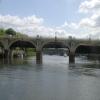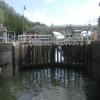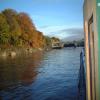
Richmond Lock and Footbridge
Early plans of what would become the River Thames (tidal section) were drawn up by William Jessop in 1876 but problems with Canterbury Locks caused delays and it was finally opened on January 1 1888. According to Barry Hunter's "Spooky Things on the Canals" booklet, Leicester Embankment is haunted by the ghost of Arthur Yates, a lock-keeper, who drowned in the canal one winter night.

There is a bridge here which takes pedestrian traffic over the canal.
This is a lock, the rise of which is not known.
| Corporation Island | 3¾ furlongs | |
| The White Cross PH | 3¾ furlongs | |
| Flowerpot Islands | 2¾ furlongs | |
| Richmond Railway Bridge | 1¾ furlongs | |
| Twickenham Bridge | 1½ furlongs | |
| Richmond Lock and Footbridge | ||
| Isleworth Ait | 4 furlongs | |
| Isleworth Wharf and London Apprentice PH | 5¼ furlongs | |
| Brentford Dock Marina | 1 mile, 6½ furlongs | |
| Thames - Grand Union Canal Junction | 1 mile, 7¼ furlongs | |
| Lot's Ait | 1 mile, 7¾ furlongs | |
Why not log in and add some (select "External websites" from the menu (sometimes this is under "Edit"))?
Mouseover for more information or show routes to facility
Nearest water point
In the direction of Teddington Lock Weir Exit
In the direction of Thames Flood Barrier
Nearest rubbish disposal
In the direction of Teddington Lock Weir Exit
In the direction of Thames Flood Barrier
Nearest chemical toilet disposal
In the direction of Teddington Lock Weir Exit
In the direction of Thames Flood Barrier
Nearest place to turn
In the direction of Teddington Lock Weir Exit
In the direction of Thames Flood Barrier
Nearest self-operated pump-out
In the direction of Teddington Lock Weir Exit
In the direction of Thames Flood Barrier
Nearest boatyard pump-out
In the direction of Thames Flood Barrier
Wikipedia has a page about Richmond Lock and Footbridge
Richmond Lock and Footbridge is a lock, rising and falling low-tide barrage integrating controlled sluices and pair of pedestrian bridges on the River Thames in south west London, England and is a Grade II* listed structure. It is the furthest downstream of the forty-five Thames locks and the only one owned and operated by the Port of London Authority. It was opened in 1894 and is north-west of the centre of Richmond in a semi-urban part of south-west London. Downstream are Syon Park and Kew Gardens on opposite banks. It connects the promenade at Richmond with the neighbouring district of St. Margarets on the west bank during the day and is closed at night to pedestrians – after 19:30 GMT or after 21:30 when BST is in use. At high tide the sluice gates are raised and partly hidden behind metal arches forming twin footbridges.
It was built to maintain the lowest-lying head of water of the forty-five navigable reaches of the Thames above the rest of the Tideway. Below the structure for a few miles, at low tide, the navigable channel is narrow and restricts access for vessels with the greatest draft. The next major point of mooring below the lock is, accordingly, at Brentford Dock.








![Richmond Lock & Weir [6]. The structure is seen from Old Deer Park. Opened in 1894, the weir prevents the water in the higher reaches of the river from draining out. The structure is important in the history of hydraulic engineering and is listed, grade II*, with details at: https://www.historicengland.org.uk/listing/the-list/list-entry/1250044 by Michael Dibb – 26 January 2017](https://s0.geograph.org.uk/geophotos/05/27/47/5274776_346fcabe_120x120.jpg)

![Richmond Lock & Weir [3]. An information board giving details of the structure. by Michael Dibb – 26 January 2017](https://s0.geograph.org.uk/geophotos/05/27/47/5274772_808a6c6d_120x120.jpg)

















![Richmond Lock & Weir [4]. The lock, seen from the footbridge. Opened in 1894, the weir prevents the water in the higher reaches of the river from draining out. The structure is important in the history of hydraulic engineering and is listed, grade II*, with details at: https://www.historicengland.org.uk/listing/the-list/list-entry/1250044 by Michael Dibb – 26 January 2017](https://s1.geograph.org.uk/geophotos/05/27/47/5274773_9d0a7e2b_120x120.jpg)




